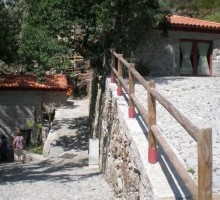The Santo Ovídio hill fort near the Vizela River basin is the most famous archaeological site of the municipality. The oldest references to the settlement located on the outskirts of the town date back to the last quarter of the 19th century, when archaeologist Martins Sarmento discovered a 1.70 m high statue of a Lusitanian warrior as they dug the foundations for building the chapel in honour of Santo Ovídio. Excavations in the settlement began in 1980, revealing the houses, roads and other important architectural elements that gave an insight into the urban development of the hill fort, presumably inhabited between the 1st century BC and the 1st century AC. Many ceramic, stone and metal artifacts were also found during the excavations, making this settlement an exceptionally interesting place for studying the Megalithic period in Northwest Iberian Peninsula. The building was listed as a public interest site in 1980.
Location: Fafe
Location: Fafe




